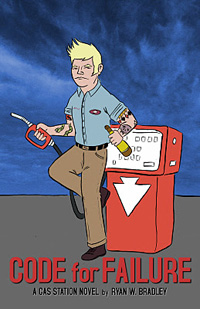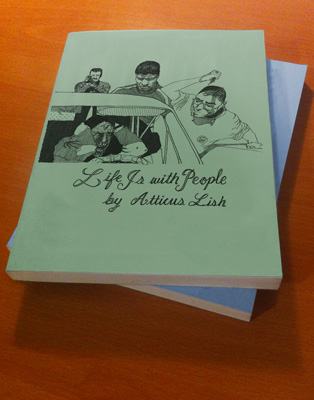B*tches in Bookshops
-Performed by La Shea Delaney (@lashea_delaney) & Annabelle Quezada (@annabelleqv)
-Director/Producer/Songwriter – Annabelle Quezada
Random Ass Live Reading of Some Recent Books I Liked #8
You missed the live reading. Excerpts were spoken from:
Partyknife by Dan Magers
The No Hellos Diet by Sam Pink
Meat Heart by Melissa Broder
Skin Horse by Olivia Cronk
A Beautiful Marsupial Afternoon by CAConrad
Crunk Juice by Steve Roggenbuck
Autoportrait by Edouard Leve
Fast Machine by Elizabeth Ellen
Percussion Grenade by Joyelle McSweeney
The Black Forest by Christopher DeWeese
Sister Stop Breathing by Chiara Barzini
Transfer Fat by Aase Berg
Big Questions
 Big Questions
Big Questions
by Anders Nilsen
Drawn and Quarterly, 2011
658 pages / $44.95 Buy from D&Q or Amazon
Ends beget origins in Anders Nilsen’s Big Questions, so it’s proper that we learn about the book’s genesis in its afterword. The author-illustrator tells us the 600-page graphic novel began 15 years ago as a workshop exercise meant to incite new illustration tactics. The assignment required that the artist draw an object 60 times on 60 separate sheets of paper in one hour. In Nilsen’s case, a narrative hatched while he moved through his 60 iterations (of what he doesn’t say). He reveals that the emergent events were about “a lost soldier in a barren landscape, a group of birds, and a plane crash.” And though the characters, landscape, and frames all become more complex and more thoughtfully wrought as the book assembles itself around you, much of the narrative stays as it was when it sprang from Nilsen’s workshop piece. Big Questions in completed form houses a fable-like tale, told in discreet scenes, about finches who eat seeds and ask questions; a flat-to-rolling landscape that’s unpeopled except for a grandmother and her probably slow grandson, the idiot, both of them ostensibly mute; things that go missing; a bomb that explodes and occasions more questions; a plane that crashes (yes, more questions); and a mysterious, somnolent pilot who emerges from that plane.
March 19th, 2012 / 1:00 pm
Noah Cicero interviews Elizabeth Ellen

Elizabeth Ellen & Kendra Grant Malone
Elizabeth Ellen writes in the classical sense: she focuses her energy on the story being told. She doesn’t two things most writers fall into: she doesn’t over styilize and use experimental weirdness to express emotion. Her stories are always very linear, have beginning/middle and end. But at the same time she doesn’t write in cliché language and have big explosive plots involving guns and beautiful people walking around. Fast Machine by Elizabeth Ellen takes the middle ground between alternative/experimental and popular literature.
The stories come out strange and unique, I think because Elizabeth Ellen is inspired by writers like Dave Eggers, but at the same time because of the circumstances of her life she did not get an MFA and go through many writing workshops, her writing turned to be a marriage of Bukowski and Eggers. The writing has some of that nice Eggers clarity and smoothness but at the same time covers Bukowski themes like humiliation, failed romantic relationships, divorse, raising a child in difficult circumstances, violent sex, drinking, weight gain, disapointment, in general about failure and hardship.
Looking for Brassneck, Looking for Significance
Little by little I’m trying to get at a deep concern I have, some means of responding to what I consider to be a common and pressing situation …
A few years back, I stumbled across the music video for the Wedding Present’s song “Brassneck.” This was that band’s first US hit (well, the version that Steve Albini rerecorded was), and a song I’d always liked well enough, whenever I happened to hear it. (It’s from their second studio album, Bizarro [1989].)
This was my first time seeing the video. I spent a great deal of the late ’80s / early ’90s watching MTV, and YouTube has helped me catch up on what I missed. And what struck me about this one is its dance choreography, which reminded me a great deal of Michael Clark’s work. You’ll recall that I’m a tremendous fan of his, in particular his work in Prospero’s Books and Hail the New Puritan. The more that I watched it, the more I became convinced that Clark had somehow been behind it. And so I emailed the Michael Clark Company, asking them whether I was right.
A Company representative graciously wrote me back:
The Perfect Stutter: My Only Wife by Jac Jemc

Consider the last breath of Jac Jemc’s forthcoming novel My Only Wife:
“My wife slid the key in the lock, turned it, and and then slipped down the stairs.
The one truth I know is that I came home.
I climbed the stairs, light and unknowing.
I slid my own key into the lock, turned and pushed.”
Notice the repetition of the word “and” in that top line. It’s a stutter so subtle it could be mistaken as a typo, but I hope it’s not a typo. I hope it’s strategically placed, because I believe it’s perfect. Such a small thing: the word and. But such a large thing it conveys.
Hesitation. Frozen in the moment, if only for a moment.
So beautifully rendered but emotionally wrenching, Jemc’s novel brings to mind images by Lucien Freud:

Two Points

1) On August 17, 1991, in CMT studios in Culver City, California, Kurt Cobain was, or at least affectedly, seen deep in the throes of executing a dissonant power chord. The video was lit as a Caravaggio painting, the dirty yellow umbers of indoor light shutting off the blue sky. A spotlight reflecting off the drum kit acts as fire, the incipient spark of a generation. The casting call summoned extras aged 18 – 25 years old dressed in “high-school persona i.e., preppy, punk, nerd, jock…,” the abbreviated, yet sadly accurate, ethos of our youth. The basketball hoop, perennial throughout the entire video, seemed both detached and stately as a crucifix. It represented the high school stadium, that place of mutual assembly, of cheerleaders and meanness, the constellation of gum hidden under bleachers. If the reader will bear with me, he and she will accept that everyone who entered CMT studios that day a little before 11:30 am was — besides one-or-two effectively null Asians (in our forthcoming yet apparent context) — white, which is less of a problem than a benign concession to the binary of race. It was simply time for white kids to freak out, and that’s okay. I’m glad I was there. 2) In 1994, following the controversial publication of The Bell Curve: Intelligence and Class Structure in American Life, which linked race to inherent qualities or even dispositions, a tenured anthropologist at U.C. Berkeley offered Michael Jordan as an example of a black person’s inherent talent, perhaps even genius, in physical ability — in this case jumping with inhuman ability — whose allusions to intellectual deficiency were sad yet subliminal. The book was quickly both dismissed and heralded by the suspecting parties. What concerns me here, though, is not race and a fractured America, of white and black boys and their respective thwarted fates proposed by dreams, but the delusional colorless hope shared by both: to see a pedestrian God so close yet so far from the net, frozen in the grace of their flourish, arms doing perfectly what needed to be done for their followers. The heavy wane of disappearing youth as a chord which drones for a long time afterwards, decades even. Two points stuffed by a weightless man, a marbled pose chiseled by spectacle, a stadium of held breath, high past a line from which others could only dare throw.
Code For Failure
 Code For Failure
Code For Failure
by Ryan W. Bradley
Black Coffee Press, March 27, 2012
255 pages / $12.95 Preorder from Black Coffee Press
When most of us make a pit stop at the local service station for a few gallons of gas, some cigarettes, or an oil change, if we’re feeling a little curious, we might stop to consider the often grizzled-seeming souls toiling behind the counter or at the pumps. What choices, either wildly spontaneous or premeditated, led them to their current career? Can we imagine their lives outside of work as distinct and complex entities and not just the bored bodies in unflattering corporate-logo jumpsuits with which we’re so familiar? Are they happy? Ryan W. Bradley can provide these answers, and then some. His autobiographical debut novel, Code for Failure, presents a searing portrait of life at the bottom rung of the fuel industry that performs the rare feat of being psychologically intricate, hilariously scatological, and emotionally memorable, often in the same paragraph. It’s a study of the rarest of dichotomies – darkly macho fiction with a heart that builds to unbearable, and maybe more.
March 16th, 2012 / 1:00 pm
Life Is with People by Atticus Lish

There was a new release from Tyrant Books yesterday. Life Is with People by Atticus Lish is 120 pages of illustrations and text by Atticus. The covers come in four different colored papers. They are thick and nice. The illustrations and text are printed on composition (lined) paper that is thick and nice. This isn’t something I can really try to sell to you. You either like it, or you do not. You either get it, or you do not. I am not saying one is better than the other. Personally, I see each page as a poem that takes awhile to sink in. I can’t really look at too many of them in one sitting. I once looked at a stack of 300 of them in one sitting and felt mental and ill for ten hours afterward. These books cost $20 to make, so I am selling them for $20. If we sell all of them, we break even. I’m not being all, “Look how generous I am.” I am being all, “I think this book is so important that I do not want any kind of deterrence from buying it for those who may not be able to afford it.” Book design by the good-eyed Ryan P. Kirby. There were only 500 of these produced. Do not hesitate. Actually, I am so behind this book that if you order one and think it was not worth your money, you can call me and tell me why and if you make one iota of sense, I will reimburse you. Cool? Cool. Thank you kindly.
The books is available through SPD, the Tyrant website, and will be in limited stores very soon.
[Previews at Vice.]

